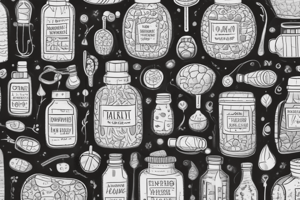Podcast
Questions and Answers
What neurotransmitter is usually stimulated by the D2 receptor in the brain?
What neurotransmitter is usually stimulated by the D2 receptor in the brain?
Which type of medications were developed in the 1950s and work by blocking the D2 receptor in the brain?
Which type of medications were developed in the 1950s and work by blocking the D2 receptor in the brain?
What is responsible for many of the side effects of traditional antipsychotic medications?
What is responsible for many of the side effects of traditional antipsychotic medications?
What was introduced in 1952 as a new potent pharmacological agent for treating psychoses?
What was introduced in 1952 as a new potent pharmacological agent for treating psychoses?
Signup and view all the answers
Which class of medications has altered the management of psychoses significantly?
Which class of medications has altered the management of psychoses significantly?
Signup and view all the answers
What do traditional antipsychotic medications have in common regarding effectiveness?
What do traditional antipsychotic medications have in common regarding effectiveness?
Signup and view all the answers
Which neurotransmitter is responsible for the positive symptoms of psychosis such as hallucinations and delusions?
Which neurotransmitter is responsible for the positive symptoms of psychosis such as hallucinations and delusions?
Signup and view all the answers
'Chemo' in 'chemotherapies' refers to:
'Chemo' in 'chemotherapies' refers to:
Signup and view all the answers
Study Notes
Overview of Psychoactive Drugs
- Psychoactive drugs are utilized in mental health treatments to support patients in the community, despite criticism regarding their curative effects.
- A patient metaphorically described these drugs, likening them to flotation devices that assist without teaching self-sufficiency.
Categories of Psychoactive Drugs
- Four main categories of psychoactive drugs are recognized:
- Neuroleptic drugs (antipsychotics)
- Anti-anxiety drugs
- Anti-depressant drugs
- Mood stabilizers (formerly classified as anti-manic drugs)
Neuroleptic Drugs (Antipsychotics)
- Designed to alleviate or minimize symptoms associated with psychosis, characterized by a disconnect from reality, including delusions and hallucinations.
- Commonly prescribed for conditions such as schizophrenia, bipolar disorder, and severe depression.
- They also enhance emotional and impulsive stability beyond patient control.
- Neuroleptics can also treat:
- Delirium and dementia
- Obsessive-compulsive disorder (OCD)
- Attention-deficit/hyperactivity disorder (ADHD)
- Eating disorders
- Mood stabilization in bipolar disorder
- Anxiety reduction in anxiety disorders
- Tics in Tourette syndrome
Classification of Neuroleptics
- Neuroleptics are classified into two generations:
- First-generation (Typical) Antipsychotic Medications
- Second-generation (Atypical) Antipsychotics
Second-Generation (Atypical) Antipsychotics
- Developed in the 1980s due to serious side effects associated with typical antipsychotics.
- Common atypical antipsychotics include:
- Clozapine
- Risperidone
- Olanzapine
- Quetiapine
- Ziprasidone
- Aripiprazole
- Paliperidone
- Lurasidone
- Atypical antipsychotics target various dopamine and serotonin receptors.
- Research indicates both typical and atypical antipsychotics are effective for:
- Treating schizophrenia
- Managing manic phases of bipolar disorder
- Clozapine, in particular, is noted for its effectiveness in patients resistant to other treatments and for addressing "negative symptoms" such as lack of motivation and flat affect.
Studying That Suits You
Use AI to generate personalized quizzes and flashcards to suit your learning preferences.
Description
Test your knowledge on psychoactive drugs used in chemotherapies and their impact on psychological disturbances. Explore the debate surrounding the effectiveness of these drugs and their role in keeping psychologically disturbed individuals in the community.




